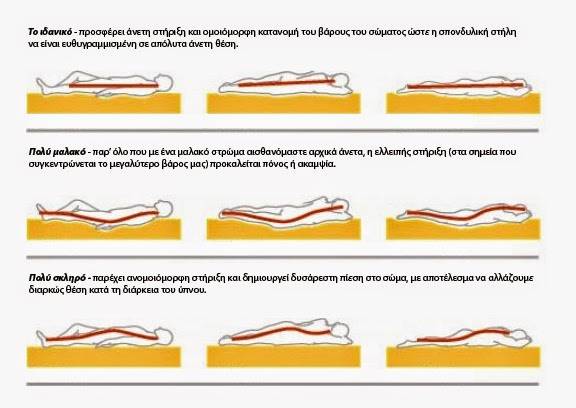Sleep is precious for our health. Tips for better sleep wouldn't be complete if we didn't look at the quality of the mattress. The right mattress is an important investment, since it plays a primary role and directly affects our mental, spiritual and of course physical health.
It is important to pay particular attention to the choice of mattress, since each of us spends more than 6-8 hours lying on it every day (about 1/3 of our life). Choosing the right mattress, although extremely difficult, guarantees a comfortable and enjoyable sleep as it will properly support your spine.
The human body, in terms of its shape, is full of curves and uneven surfaces. By no means, however, is it straight, straight or flat. This is true regardless of weight, weight distribution and body type.
In order for the human body to rest, muscle contractions must be eliminated without altering the body's natural shape. This is achieved when our entire body is supported by the mattress and every part of it is filled with material. That is, when the mattress adapts to the shape of the body and not the other way around.
But according to the above, which is the right mattress? the hard, the soft or the elastic? The orthopedic or anatomical mattress?
Let's look at each one separately:

a) The hard layer, being rigid, cannot "follow" the curves of the body and adapt to them. Thus, in the places that have strong curves, or are very light (neck, lumbar region, legs, arms) there are unsupported gaps resulting in their incorrect support. The elimination of every muscle contraction is a necessary condition for the correct and complete rest of the body. which cannot be achieved with hard layers. On the contrary, the hard layer "attempts" to straighten the body, that is, to alter its natural shape, as a result of which it suffers and causes damage in the long term.
However, for many decades the perception prevailed that the hard mattress is ideal for the proper support of the body, because it "keeps" the spine in a straight position! (This perception has not completely disappeared nowadays). This is due to the fact that the materials used in the construction of the mattresses were soft but without rebound (wool, cotton, etc.) with the result that they sink slowly and with them the user of the mattress also sinks. The effects on the lumbar region and the spine in general were inevitable. The doctor, whom the patient was visiting, knowing that there were no materials with elasticity and recovery on the market, recommended, in order to deal with the problem immediately, sleeping on a hard mattress, so that at least the body does not sink. That is, they recommended the least evil. This advice has become distorted over time and many people have come to believe that the best mattress for their ailments is a straight, hard and rigid floor. It is however obvious, even to the layman, that the spine and the whole body in general it is anything but straight. In addition, the hard layer burdens the circulatory system, as it prevents the proper circulation of blood, especially in the heavy parts of the body, as a result of which angulations and numbness are caused.
b) The soft mattress, having no rebound, sinks and becomes like a hammock when a body lies on it. Thus, it distorts the body by "sucking" it in, consequently contributing to causing injuries such as scoliosis and kyphosis.
The concepts of "soft" and "hard" in relation to layers are subjective. That is, they depend on the weight and body structure in general of the body lying on the mattress. For example the same mattress is soft for a body weighing 80 kg and hard for a body weighing 40 kg.
c) The elastic layer is the right layer for the correct support of the body, because elastic means that it adapts exactly to the shape of the body. Thus, the body maintains its natural posture, i.e. the posture it has when standing upright.
Moreover, in contrast to the concepts of "hardness" and "softness", the concept of elasticity has an objective character. It is scientifically approachable and laboratory measurable.
ORTHOPEDIC – ANATOMICAL – ORTHOSOMATIC – ORTHAUCHENIC
The term orthopedic mattress is unacceptable since it describes certain hard mattresses that have been manufactured to someone else's measurements and not ours. The same applies to the term anatomical. Mattresses are arbitrarily named as such.
The following terms may be test terms in our description.
ORTHOSOMATIC for the proper mattress and ORTHAUCHENIC for the proper pillow
Because each person's needs and preferences are different, the right mattress is not the same for everyone. In general, however, we can say that it should help align and support the spine and head and absorb the pressure of the shoulders, legs and pelvis.
Of course, how well we take care of our mattress is of great importance. But you should know that even a good quality mattress, with normal use, will not last more than about 10 years.
How can you tell if your mattress needs changing?
The Sleep Council UK suggests a simple way to determine whether or not your mattress needs changing.
Answer with a simple yes or no to the questions below:
- Is your mattress over 10 years old?
- Do you wake up with neck or back pain?
- Is the mattress cover torn or soiled?
- Όταν ξαπλώνετε, νιώθετε τις σούστες ή πτυχές κάτω από την επιφάνεια;
- When you move in the mattress, you hear creaks,
or other noises? - Do you or your partner accidentally roll on top of each other on the mattress?
- Is your mattress too small to give you an undisturbed sleep?
- Is the sofa or base uneven or clogged?
- Are the legs and/or wheels worn?
- Would it embarrass you if the neighbors saw your mattress without a cover?
If you answered yes to three of the above questions, then you are not sleeping as well as possible.
Five or more positive answers means it's time to buy a new bed.
Even our preferred sleeping position is a criterion for choosing the right type

In general, semi-hard mattresses are indicated for those who sleep on their face, hard for those who sleep on their backs and soft mattresses for those who sleep on their side. It is preferable to buy a mattress and underlay as it provides better support to the body. The more layers a bed has, the better the support for the body.
The minimum thickness of the layer should be 16 cm, ideally over 18-20 cm.
Of course, we also check the inside of the mattress, so of course it is preferable to choose mattresses with a zipper on the outside so that you can see the inside structure and materials of the mattress.
In summary, the mattress should:
- to adapt to the shape of the body and especially the spine
- to distribute pressure evenly along the body, reduce body movement and improve sleep quality
- to provide perimeter support
- to be properly maintained
Correct maintenance of the mattress is as important as its choice.
To keep the mattress in good condition, it should be turned upside down (upside down and head and feet) every three months so that it wears evenly. Ventilate it well by lifting all covers and wash the protective cover often with cold water and mild detergent. We must not let the mattress get wet and we must not use dry cleaning materials because chemicals can damage the inside of the mattress.

Buying the right pillows is also important. Pillows are filled with feathers or pliable foam materials. It is preferable to use pillows with feathers, the most suitable of which are duck, while their height and number depends on the preferences of each person. During sleep the neck should be placed in line with the trunk and not bent or extended significantly.
Choosing the right mattress and bed for your needs takes time. Dedicate it and don't forget that you will spend a third of your life in your mattress.
Source: Dr. Georgios F. Spiliotopoulos-Orthopedic Surgeon https://www.orthosoma.gr/sosto-stroma-ta-ofeli-tou-kai-pos-to-epilegoume/
